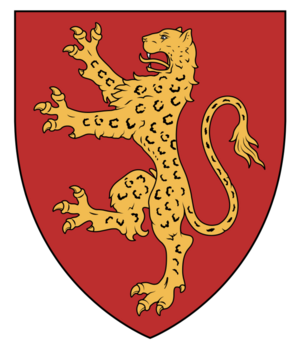House of De Pardo: Difference between revisions
(Created page with "{{Short description|Pelaxian noble family}} {{Infobox organization |native_name = Casa De Pardo |logo = 774px-Leopard Natural.svg.png |image_size = 168px |caption = Coat of arms of House of De Pardo |type = Noble house | region_served = Pelaxia |parent house = |affiliations = {{bulleted list|Duke of Agrila|King of Pelaxia}} |founded = {{Start date|1200}} |fou...") |
mNo edit summary |
||
| Line 9: | Line 9: | ||
|parent house = | |parent house = | ||
|affiliations = {{bulleted list|[[Counts and dukes of Guise|Duke of Agrila]]|[[King of Pelaxia]]}} | |affiliations = {{bulleted list|[[Counts and dukes of Guise|Duke of Agrila]]|[[King of Pelaxia]]}} | ||
|founded = {{Start date| | |founded = {{Start date|1105}} | ||
|founder = [[Elvio, Baron of Guiso|Elvio of Guiso]] | |founder = [[Elvio, Baron of Guiso|Elvio of Guiso]] | ||
|final ruler = | |final ruler = | ||
| Line 24: | Line 24: | ||
The intention of the union was to create a common state under Albalitorian law, with the support of the ruling oligarchy in the Montian Confederacy. Castro-Brine would gain access to the trade passes through the Picos into the Dominate of Caphiria, while the Confederates would gain access to Albalitorian ports and sea routes. Thus, in the Jeronimian period, Pelaxia developed as a feudal state with a predominantly agricultural economy and an increasingly dominant mercantile nobility. The Cortes Regium act adopted by Jerónimo established the Corte General in 1516 and in 1605 transferred most of the legislative power in the state from the monarch to the Corte. This event marked the beginning of the period known as "Golden Liberty", when the state was ruled by the "free and equal" members of the Pelaxian aristocracy and nobility. | The intention of the union was to create a common state under Albalitorian law, with the support of the ruling oligarchy in the Montian Confederacy. Castro-Brine would gain access to the trade passes through the Picos into the Dominate of Caphiria, while the Confederates would gain access to Albalitorian ports and sea routes. Thus, in the Jeronimian period, Pelaxia developed as a feudal state with a predominantly agricultural economy and an increasingly dominant mercantile nobility. The Cortes Regium act adopted by Jerónimo established the Corte General in 1516 and in 1605 transferred most of the legislative power in the state from the monarch to the Corte. This event marked the beginning of the period known as "Golden Liberty", when the state was ruled by the "free and equal" members of the Pelaxian aristocracy and nobility. | ||
=Origins= | |||
==Myths== | |||
==From Barons to Kings== | |||
==Family Tree== | |||
=Notable Members= | |||
Revision as of 08:44, 16 September 2022
Script error: The module returned a nil value. It is supposed to return an export table.
| Casa De Pardo | |
 | |
| Founded | 1105 |
|---|---|
| Founder | Elvio of Guiso |
| Type | Noble house |
Region served | Pelaxia |
| Affiliations | |
The House of De Pardo, alternatively spelled Pard in English (Pelaxian: Casa De Pardo; Cartadanian: Casa Do Pardo, Latin: Domus Pardus) and also known as the House of Pelaxia (Pelaxia: Casa de Pelaxia; Cartadanian: Casa da Pelaxia) is one of the most prominent dynasties in Sarpedonian history.
The house takes its name from Elvio De Pardo, a ranger to the Duke of Agrila and, who in one afternoon saved his lord from an attack by a Pelaxian leopard. After saving the lord of Agrila, he was awarded lands in the dukedom by him. Elvio would take the image of the leopard as a symbol of his family and surname, having fought with the same ferocity as the top predator in these valleys.
In 1485, his descendant Jerónimo de Pardo, now Duke of Agrila himself, would craft the Union of Termia between him, Reginaldo Castro-Brine of Alabalitoria and the Head Chancellor of the Montian Confederacy. The act arranged for Reignaldo's daughter Josefina to marry Jerónimo, which established the beginning of the Pelaxian Kingdom, still a vassal realm to Caphiria. The union strengthened both regions as self appointed protectors of Pelaxia, in their shared opposition to the newly formed Kingdom of Savria under King Didac l, self-appointed protector of the south.
The intention of the union was to create a common state under Albalitorian law, with the support of the ruling oligarchy in the Montian Confederacy. Castro-Brine would gain access to the trade passes through the Picos into the Dominate of Caphiria, while the Confederates would gain access to Albalitorian ports and sea routes. Thus, in the Jeronimian period, Pelaxia developed as a feudal state with a predominantly agricultural economy and an increasingly dominant mercantile nobility. The Cortes Regium act adopted by Jerónimo established the Corte General in 1516 and in 1605 transferred most of the legislative power in the state from the monarch to the Corte. This event marked the beginning of the period known as "Golden Liberty", when the state was ruled by the "free and equal" members of the Pelaxian aristocracy and nobility.